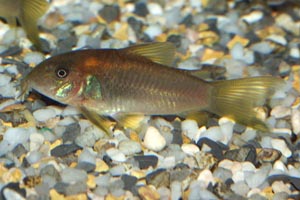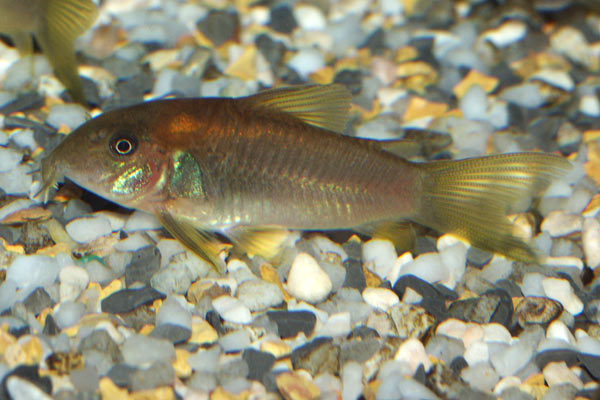

Species Profile | Images | Breeding Report | Similar Species

(Other members of the genus Corydoras)
ADULT SIZE: 7 cm
WATER CONDITIONS: Not critical
TEMPERATURE RANGE: 24-28 C
FOOD: Feed Corydoras aeneus small live-foods and fine grade dried foods
DISTRIBUTION: This species comes from Argentina, Bolivia, Brazil, Colombia, French Guiana, Guinea, Paraguay, Peru, Surinam, Venezuela
SEXUAL DIFFERENCES: Females of this species are larger and more rounded than males.
AQUARIUM CARE: Like all corycats, does best in a small shoal of six plus individuals. An easy species ideal for a well planted community. This species has a wide distribution in southern America, and will fit well into an Amazonian tanks with swordplants, leaflitter and sunken bogwood.
This catfish will eat most live and dry foods, but is particularly fond of worms and small crustaceans.
C. aeneus does fine in a peaceful community tank with small shoalers fish: tetras, danios, killifish etc. Aggressive fish, cichlids for example are problematic in all but the largest aquariums at spawning time.
BREEDING: Breeding is triggered by the start of the rainy season in the wild; a situation easily replicated in captivity by a large water change of slightly cooler water. Eggs are typically laid on stones, plants, and often the aquarium glass.
Have you bred Corydoras aeneus? Why not fill in a breeding questionaire?, or examine existing Corydoras aeneus breeding reports
Other members of the genus Corydoras
Other catfish species
Other species from Argentina, Bolivia, Brazil, Colombia, French Guiana, Guinea, Paraguay, Peru, Surinam, Venezuela

The bronze cory is very common across South America, and in the aquarium trade
BREEDING: Breeding is triggered by the start of the rainy season in the wild; a situation easily replicated in captivity by a large water change of slightly cooler water. Eggs are typically laid on stones, plants, and often the aquarium glass.
Have you bred Corydoras aeneus? Why not fill in a breeding questionaire?
This page summarises breeding reports provided by visitors to this site, along with some statistical analysis. Please feel free to contribute - whatever your experience!
| |||||||||
|
| ||||||||
|
| ||||||||
|
| ||||||||
|
| ||||||||
Remember, each record represents only one persons experience; if you had different results, or used different methods, please share your experiences
| Water conditions: Moderately soft and acidic | Water temperature: 20-23oC |
| Disposition: Active, but not aggresive | Community tank?: Yes, a good community fish |
| Spawning Method: Other (see below) | Breeding problems: Poor egg survival |
| Sex ratio: Roughly equal | Breeding difficulty: Easy |
| Sucess: Average | Years Experience: 5 |
| Other Comments: when you the males harassing the females do a partial water change and fill it with cooler water until the temperature is lowered from 72F to about 70F then start feeding them more often(small snacks throughout the day) of live or frozen bloodworms and catfish pellets. also remember to remove all the tankmates. my blue gourami and the corys ate the ones I didnt scrape off of the tank glass-and you have to be careful when you do that! | |
| Date this record created: 6th May 2009 | Breeding date: 2006 |
| Breeder: Henry | Location: Sacramento, CA |